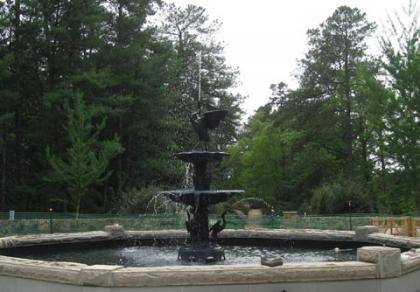Roney Fountain Flowing Again
Reconstructed top has campus landmark looking like its original state

Water flowed this week for the first time in over
75 years through all three tiers of the Roney Fountain, after it was moved from
East Campus to Duke Gardens.
Getting it to its original splendor took an
impressive effort from a collection of archivists, architects and Duke Gardens
officials.
At one point, the fountain was one of the glory
spots of the campus. A 1933
article on the Woman's College described "tall cat-tails and green umbrella
plants ... planted around the edge of the pool, their shivering reflections in
the water making a shadow over the floating pink and white water lilies. Blue
water hyacinths and yellow water poppies with their big leaves are interspersed
among the lilies. The fount itself has been converted into a bird bath, and
around it are planted pickerel weed and pink Egyptian lotus."
But even at the time of that article, the
fountain was falling into disrepair.
It was already missing its original two top tiers, flanked by birds and
topped by a crane with its wings spread.
What happened is a mystery, said Duke Gardens Director Bill LeFevre.
"We have a picture taken in 1921 showing the
entire fountain, with the crane on the top," LeFevre said. "And we have a photograph from 1933
showing just the lower bowl. We
have nothing in the records, but between 1921 and 1933, somebody removed the
top tiers and left just the bowl."
It remained in that state until this year. A 2010
Duke report on the fountain stated, "Today, the fountain remains in its 1930's
configuration, but is heavily shaded by the large magnolia trees around it. Its
metalwork is rusted, the basin in disrepair, and water is stagnant."
Its condition caught the attention of LeFevre,
who was looking for another showpiece for the Gardens. As he investigated the possibility of
moving it to Duke Gardens, LeFevre found that University Archivist Tim Pyatt
was tracking the fountain's history.
Pyatt learned the original molds were made by the
J.L. Mott Co. of New York City but were currently in the possession of Robinson
Ironworks in Alabama. Those molds were used to recreate the fountain's top
tiers.
Now the fountain stands in its original form in
the Rose Garden, which is the first main feature visitors encounter when they
enter Duke Gardens through the Gothic gates. The project was aided by a bequest
from the late Dr. J. Robert Teabeaut II, a Duke alumnus, in honor of Mary Duke
Biddle Trent Semans.
LeFevre thanked everyone who worked on the
project. "By the initial reaction
of gardens visitors, it's a keeper!" he said.